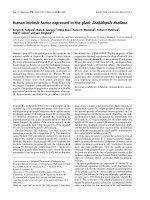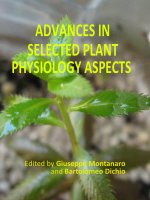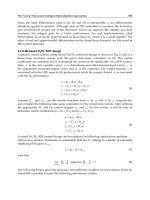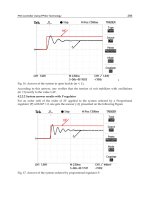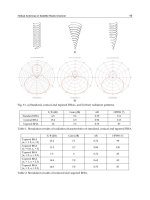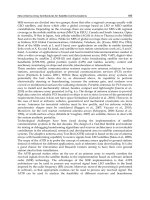ADVANCES IN SELECTED PLANT PHYSIOLOGY ASPECTS doc
Bạn đang xem bản rút gọn của tài liệu. Xem và tải ngay bản đầy đủ của tài liệu tại đây (16.55 MB, 397 trang )
ADVANCES IN
SELECTED PLANT
PHYSIOLOGY ASPECTS
Edited by Giuseppe Montanaro
and Bartolomeo Dichio
ADVANCES IN
SELECTED PLANT
PHYSIOLOGY ASPECTS
Edited by Giuseppe Montanaro
and Bartolomeo Dichio
Advances in Selected Plant Physiology Aspects
Edited by Giuseppe Montanaro and Bartolomeo Dichio
Published by InTech
Janeza Trdine 9, 51000 Rijeka, Croatia
Copyright © 2012 InTech
All chapters are Open Access distributed under the Creative Commons Attribution 3.0
license, which allows users to download, copy and build upon published articles even for
commercial purposes, as long as the author and publisher are properly credited, which
ensures maximum dissemination and a wider impact of our publications. After this work
has been published by InTech, authors have the right to republish it, in whole or part, in
any publication of which they are the author, and to make other personal use of the
work. Any republication, referencing or personal use of the work must explicitly identify
the original source.
As for readers, this license allows users to download, copy and build upon published
chapters even for commercial purposes, as long as the author and publisher are properly
credited, which ensures maximum dissemination and a wider impact of our publications.
Notice
Statements and opinions expressed in the chapters are these of the individual contributors
and not necessarily those of the editors or publisher. No responsibility is accepted for the
accuracy of information contained in the published chapters. The publisher assumes no
responsibility for any damage or injury to persons or property arising out of the use of any
materials, instructions, methods or ideas contained in the book.
Publishing Process Manager Masa Vidovic
Technical Editor Teodora Smiljanic
Cover Designer InTech Design Team
First published April, 2012
Printed in Croatia
A free online edition of this book is available at www.intechopen.com
Additional hard copies can be obtained from
Advances in Selected Plant Physiology Aspects,
Edited by Giuseppe Montanaro and Bartolomeo Dichio
p. cm.
ISBN 978-953-51-0557-2
Contents
Preface IX
Section 1 Abiotic Stress 1
Chapter 1 Abiotic Stress Responses in
Plants: A Focus on the SRO Family 3
Rebecca S. Lamb
Chapter 2 Characterization of Plant Antioxidative
System in Response to Abiotic Stresses:
A Focus on Heavy Metal Toxicity 23
Miguel Mourato, Rafaela Reis and Luisa Louro Martins
Chapter 3 Genetic and Molecular Aspects of Plant
Response to Drought in Annual Crop Species 45
Anna M. De Leonardis, Maria Petrarulo,
Pasquale De Vita and Anna M. Mastrangelo
Chapter 4 Plant-Heavy Metal Interaction:
Phytoremediation, Biofortification and Nanoparticles 75
Elena Masarovičová and Katarína Kráľová
Section 2 Plant Water Relations 103
Chapter 5 Plant Water Relations: Absorption,
Transport and Control Mechanisms 105
Geraldo Chavarria and Henrique Pessoa dos Santos
Chapter 6 Defence Strategies of Annual Plants Against Drought 133
Eszter Nemeskéri, Krisztina Molnár, Róbert Víg,
Attila Dobos and János Nagy
Section 3 Mineral Nutrition and Root Absorption Processes 159
Chapter 7 Soil Fungi-Plant Interaction 161
Giuseppe Tataranni, Bartolomeo Dichio and Cristos Xiloyannis
VI Contents
Chapter 8 Plant-Soil-Microorganism Interactions
on Nitrogen Cycle: Azospirillum Inoculation 189
Elda B. R. Perotti and Alejandro Pidello
Chapter 9 Selenium Metabolism in Plants: Molecular Approaches 209
Özgür Çakır, Neslihan Turgut-Kara and Şule Arı
Chapter 10 Fruit Transpiration: Mechanisms and
Significance for Fruit Nutrition and Growth 233
Giuseppe Montanaro, Bartolomeo Dichio and Cristos Xiloyannis
Chapter 11 Significance of UV-C Hormesis and Its Relation to Some
Phytochemicals in Ripening and Senescence Process 251
Maharaj Rohanie and Mohammed Ayoub
Chapter 12 The Role of Root-Produced Volatile Secondary
Metabolites in Mediating Soil Interactions 269
Sergio Rasmann, Ivan Hiltpold and Jared Ali
Section 4 Reproduction 291
Chapter 13 Cytokinins and Their Possible Role in
Seed Size and Seed Mass Determination in Maize 293
Tomaž Rijavec, Qin-Bao Li,
Marina Dermastia
and Prem S. Chourey
Chapter 14 Nutritional and Proteomic Profiles
in Developing Olive Inflorescence 309
Christina K. Kitsaki, Nikos Maragos and Dimitris L. Bouranis
Chapter 15 Regulatory Mechanism in Sexual
and Asexual Cycles of Dictyostelium 327
Aiko Amagai
Chapter 16 Terpenoids and Gibberellic Acids Interaction in Plants 345
Zahra Asrar
Chapter 17 Lipotubuloids – Structure and Function 365
Maria Kwiatkowska, Katarzyna Popłońska, Dariusz Stępiński,
Agnieszka Wojtczak, Justyna Teresa Polit and Katarzyna Paszak
Preface
The book provides general principles and new insights of some plant physiology
aspects covering abiotic stress, plant water relations, mineral nutrition and
reproduction.
Plant response to reduced water availability and other abiotic stress (e.g. metals) have
been analysed through changes in water absorption and transport mechanisms and
also by molecular and genetic approach. A relatively new aspects of fruit nutrition are
presented in order to provide the basis for the improvement of some fruit quality
traits. The involvement of hormones, nutritional and proteomic plant profiles together
with some structure/function of sexual components have also been addressed. Written
by leading scientists from around the world it may serve as source of methods,
theories, ideas and tools for students, researchers and experts in that areas of plant
physiology.
Dr. Giuseppe Montanaro
Prof. Bartolomeo Dichio
Department of Crop Systems,
Forestry and Environmental Sciences,
University of Basilicata,
Italy
Section 1
Abiotic Stress
1
Abiotic Stress Responses in Plants:
A Focus on the SRO Family
Rebecca S. Lamb
Department of Molecular Genetics, The Ohio State University, Columbus, OH
USA
1. Introduction
Plants are sessile organisms and as such must have mechanisms to deal with both abiotic
and biotic stresses to ensure survival. The term “abiotic stress” includes many stresses
caused by environmental conditions such as drought, salinity, UV and extreme
temperatures. Due to global climate change it is predicted that abiotic stresses will increase
in the near future and have substantial impacts on crop yields (Intergovernmental Panel of
Climate Change; ). Therefore, understanding abiotic stress responses
and the connection between such responses and agronomically important traits is one of the
most important topics in plant science. Often plants will experience more than one abiotic
stress at a time, making it difficult to determine the effect of a single stress under field
conditions. Therefore, much of the progress in understanding plant defence signaling and
response has come from laboratory studies, especially those using the model plant species
Arabidopsis thaliana, which belongs to the family Brassicaceae.
1.1 Responses to different abiotic stresses share common components
An understanding of abiotic stress responses depends on an understanding of the molecular
processes underlying those responses. Plant defences against different abiotic stresses have
both common and unique elements. Common elements include increases in reactive oxygen
species (ROS) and cytosolic Ca
2+
as well as activation of kinase casades. In addition, stresses
can lead to increased concentrations of hormones such as salicylic acid (SA), jasmonic acid
(JA), abscisic acid (ABA) and ethylene, all of which have been implicated in response to
environmental conditions (reviewed in (Hirayama & Shinozaki, 2010)).
The increase in ROS is an especially important common connection between different
stresses. ROS are continuously produced in the plant through cellular metabolism and
plants have many antioxidants and scavenging enzymes to maintain homeostasis. However,
under stress conditions ROS accumulates. Although these molecules can damage cells
(Moller et al., 2007), they are also known to have signalling functions (Foyer & Noctor, 2009).
In fact, while excess ROS is toxic, a certain level of ROS production is necessary for a
successful response to stress, including salt (Kaye et al., 2011). In addition, ROS
accumulation has been shown to have a role in priming plants for enhanced stress resistance
(reviewed in (Conrath, 2011)). However, excess ROS can lead to cell death (Kangasjarvi et
al., 2005; Overmyer et al., 2005) and perturb development (Tognetti et al., 2011).
Advances in Selected Plant Physiology Aspects
4
1.2 Abiotic stress causes largescale changes in gene expression
Plant defences are characterized by large reprogramming of gene expression, much of it
through regulation of transcription. Research over the last two decades has lead to the
identification of many stress-inducible genes, especially since the publication of the
Arabidopsis genome (Arabidopsis Genome Initiative, 2000), which allowed global gene
expression experiments. Since 2000, several other plant species have had their genomes
sequenced, allowing expansion of this type of analysis. Functional analysis has confirmed
the importance of many of these genes in stress tolerance. More recently, genes whose
expression is downregulated under stress conditions have received attention (Bustos et al.,
2010). It is now understood that transcriptional repression responses are an integral part of
adaptive responses to stress.
To mount an effective defence, ultimately a transcription factor needs to bind and activate or
repress its target genes. Since there are both common and unique effects from different
stresses, comparison of the transcriptional profiles of such stresses has revealed both
common and unique gene activation and repression patterns and lead to the development of
models of transcriptional regulation of abiotic stress responses. The transcriptional control
of stress can be divided into several temporal phases, most likely due to varying
dependency on different signaling molecules or protein synthesis (Yamaguchi-Shinozaki &
Shinozaki, 2006). Changes can begin within 15-30 minutes of exposure and last for several
days (Kilian et al., 2007). The common stress transcriptome represent a shared response and
is likely responsible for the widely observed cross-protection where exposure to a given
stress increases the resistance of the plant to a second.
Many transcription factors involved in stress responses have been identified. Often the
expression of genes encoding these transcription factors responds rapidly to abiotic stress
treatments (Gadjev et al., 2006; Kilian et al., 2007). During domestification of crops, selection
for stress tolerance has acted on such transcription factors (Lata et al., 2011), underlining
their importance. These proteins have also been targets for development of abiotic stress
tolerant transgenic plants (Hussain et al., 2011). Transcription factors that regulate stress
responses belong to many different families. However, there are certain families that include
a relatively large number of members that have been implicated in environmental response.
These include the DREB1/CBF family of AP2 transcription factors (Lata & Prasad, 2011) as
well as other AP2-type factors (Dietz et al., 2010), Class I homeodomain-leucine zipper
proteins (Elhiti & Stasolla, 2009) and the WRKY family (Rushton et al., 2011). Interestingly,
the families mentioned here are all plant-specific (Riechmann et al., 2000), suggesting that
they may have evolved to help plants deal with the stress of life on land. However,
members of transcription factor families that are found outside of plants have also been
implicated in control of stress-inducible gene expression.
The activity of these transcription factors is also controlled at posttranscriptional levels. Of
particular note, they can be regulated through protein-protein interactions and/or
posttranslational modifications. For example, AtMEKK1 can phosphorylate WRKY53 and
regulate its activity during senescence (Miao et al., 2007). DREB2A, which when
constitutively active confers salt and high temperature tolerance (Sakuma et al., 2006b),
interacts with the Med25 subunit of the Mediator complex to regulate gene expression
(Elfving et al., 2011), while heterodimers of bZIP1 and bZIP53 act together to activate
Abiotic Stress Responses in Plants: A Focus on the SRO Family
5
transcription during low energy stress (Dietrich et al., 2011). Thus, the protein complexes in
which transcription factors are found and the modifications they have are essential to
determine their activity.
1.3 Epigenetic control of abiotic stress response
As discussed above, upon stress plants reprogram their transcriptome. Although
transcription factors are important for this reprogramming, it is thought that alteration of
chromatin structure is also critical (Arnholdt-Schmitt, 2004). Genomic DNA is packaged
around nucleosomes into chromatin, the confirmation of which can restrict access of
proteins to the DNA. Therefore, transcription is heavily influenced by dynamic changes in
chromatin structure (Kwon & Wagner, 2007). Chromatin structure is regulated by several
mechanisms, including histone and DNA modifications, chromatin remodelling, which uses
ATP hydrolysis to alter histone-DNA contacts, and histone variants (JM. Kim et al., 2010;
Pfluger & Wagner, 2007). Alterations in chromatin structure are known to impact stress
tolerance (JM. Kim et al., 2010).
Posttranslational modifications of histones are one of the best-studied aspects of
chromatin regulation. Over 25 sites of histone modification have been identified in
Arabidopsis (Zhang et al., 2007) and the pattern of modification is known to alter upon
stress (JM. Kim et al., 2008). For example, a decrease in trimethylation of histone H3 Lys27
(H3K27me3), which is a maker of less transcriptionally active genes, is seen at cold-
responsive loci upon exposure to cold (Kwon et al., 2009). Some of the proteins
responsible for histone modifications have been implicated in abiotic stress response as
well. The histone deacetylase HDA6 is involved in ABA signalling and salt stress response
and required for jasmonate-induced gene expression in addition to a role in flowering
time control (LT. Chen et al., 2010; K. Wu et al., 2008; Yu et al., 2011). It is also necessary
for freezing tolerance (To et al., 2011a). Mutations in HOS15, which encodes a WD-repeat
protein, cause hypersensitivity to freezing and HOS15 increases deacetylation of histone
H4 (Chinnusamy et al., 2008; J. Zhu et al., 2008). The histone acetylase AtGCN5 has roles
in gene expression in response to cold and light (Benhamed et al., 2006; Stockinger et al.,
2001). Many more such connections are being discovered.
Another important level at which gene expression is epigenetically controlled is degree of
nucleosome coverage of a gene. Generally, nucleosome density is decreased and chromatin
structure relaxed when transcription is activated (Lieb & Clarke, 2005). Chromatin
remodelling factors are necessary for the rearrangement of nucleosomes on DNA and
several of these have been implicated in stress response. For example, the SWI/SNF family
member AtCHR12 has been shown to mediate the transient growth arrest seen under
adverse environmental conditions (Mlynarova et al., 2007). Another member of this family,
SPLAYED (SYD), also regulates stress pathways (Walley et al., 2008). DEAD-box helicases,
which unwind duplex DNA or RNA, can also affect chromatin structure and several have
been implicated in various stress responses (Vashisht & Tuteja, 2006). Interestingly, in
Arabidopsis nucleosomal DNA is more highly methylated than flanking DNA and
nucleosomes are enriched on exons (Chodavarapu et al., 2010). Genes whose coding regions
are methylated tend to be longer and more functionally important and include many stress-
regulated genes (Takuno & Gaut, 2011). In plants DNA methylation status is dynamic,
regulated by DNA methylation and demethylation reactions and influenced by histone
Advances in Selected Plant Physiology Aspects
6
modifications (reviewed in (He et al., 2011)). High DNA methylation is associated with
silenced transposable elements. However, this modification also functions in gene
regulation and transcribed genes will also contain methylated bases. Although the
involvement of DNA methylation in abiotic stress response has not been extensively
examined, it is involved in defence against gemini viruses (Raja et al., 2008, 2010) and
important in the vernalization response (DH. Kim et al., 2009). In addition, the histone
deactylase HDA6, discussed above, has been shown to regulate silencing in cooperation
with the DNA methyltransferase MET1 (To et al., 2011b), providing a link from DNA
methylation to ABA and jasmonate signalling.
1.4 Costs of defense responses
Plants have developed many sophisticated defence pathways to allow them to thrive even
in the presence of suboptimal environmental conditions. Phenotypes involved in tolerance
or defence against environmental stress can be inducible or constitutive. The evolution of
induced responses is thought be the result of the high cost of maintaining the response in
the absence of stress. This is because of the reallocation of energy and resources to defence
from growth and reproduction (Walters & Heil, 2007). Research has begun to measure the
benefits and costs of adaptation to stressful conditions, for example during cold acclimation
(Zhen et al., 2011) and tolerance (Jackson et al., 2004). In addition, analysis of mutant and
transgenic plants with derepressed stress responses to both biotic and abiotic stresses often
have developmental abnormalities and reduced seed set. For example, CONSTITUTIVE
EXPRESSION OF PR GENES5 (CPR5) was originally identified in a mutant screen for
constitutive expression of systemic acquired resistance; the cpr5 mutant has chlorotic lesions,
reduced trichome development and stunted growth (Bowling et al., 1997). CPR5 encodes a
transmembrane protein that represses leaf senescence and pathogen-defence responses in
Arabidopsis (Kirik et al., 2001; Yoshida et al., 2002). An altered cellular redox state is present
in cpr5 mutants, which underlies the chlorotic lesions and maybe the other developmental
defects as well (Jing et al., 2008) and CPR5 has been hypothesized to act as a repressor of
ROS accumulation (Jing & Dijkwel, 2008).
The cost of stress response is reflected in a phenotype observed in plants exposed to chronic,
sublethal abiotic stress, the so-called stress-induced morphogenetic response (SIMR; (Potters
et al., 2007; Tognetti et al., 2011)). SIMR is characterized by reduced cell elongation, blockage
of cell division in primary meristems and activation of secondary meristems (Potters et al.,
2009). Plants displaying SIMR often show accumulation of antioxidants and other
compounds that act as modulators of stress responses. It is thought that these changes allow
the redistribution of resources to stress response pathways, permitting plants to acclimate to
their environment. Another aspect of the SIMR response is accelerated flowering, a response
that has been associated with many abiotic stresses, including nutrient deficiency (Wada et
al., 2010; Wada & Takeno, 2010) and salinity (Ryu et al., 2011) and is thought to guarantee
reproduction before any potential lethality caused by stress. SIMR has been hypothesized to
be mediated by accumulation of ROS caused by the stressful conditions and subsequent
alterations in auxin accumulation and signaling (Potters et al., 2007; Tognetti et al., 2011). In
Arabidopsis, SIMR has been shown to be induced under several different abiotic stress
conditions (Potters et al., 2007; 2009), including salt stress (Zolla et al., 2009) and exposure to
the nonprotein amino acid amino-butyric acid (CC. Wu et al., 2010).
Abiotic Stress Responses in Plants: A Focus on the SRO Family
7
Fig. 1. The SRO family of PARP-like proteins is plant specific. A. Simplified phylogeny of
Plantae. Branch lengths do not reflect genetic distance. Presence or absence of PARP
superfamily members and SRO subfamily members are indicated, based on ((Citarelli et al.,
2010) and searches of EuroPineDB (for Pinus pinaster; (Fernandez-Pozo et al., 2011)) and the
potato genome (Potato Genome Sequencing Consortium, 2011)). B. Schematic representaion
of domains found in two representative Arabidopsis SRO family members. Protein domains
are illustrated by colored boxes and defined according to Pfam 25.0 (Finn. et al., 2010).
Advances in Selected Plant Physiology Aspects
8
2. The SRO family: A novel group of poly(ADP-ribose) polymerase-like
proteins found only in land plants
The poly(ADP-ribose) polymerase (PARP) superfamily is distributed across the breadth of
the eukaryotes (Citarelli et al., 2010) and was first identified as enzymes that catalyze the
posttranslational modification of proteins by multiple ADP-ribose moieties (poly(ADP-
ribosyl)ation; (Chambon et al., 1963)). It is now recognized that there are many types of
PARPs and PARP-like proteins; they are characterized by a shared PARP catalytic domain
but differ outside of this domain. The functions of these proteins have also expanded and
some members of this family do not act in poly(ADP-ribosyl)ation. Bona fide PARPs attach
ADP-ribose subunits from nicotinamide adenine dinucleotide (NAD
+
) to target proteins
(MY. Kim, 2005). However, other members of the PARP superfamily have been shown to
have either mono(ADP-ribose) transferase (mART) activity (Kleine et al., 2008) or to be
enzymatically inactive (Aguiar et al., 2005; Jaspers et al., 2010b; Kleine et al., 2008; Till et al.,
2008). Biologically, PARP superfamily members are involved in a broad range of functions,
including DNA damage repair, cell death pathways, transcription and chromatin
modification/remodeling (reviewed in (Hassa & Hottiger, 2008)).
Although non-enzymatically active PARP superfamily members have not been as well
studied as those with known poly(ADP-ribosyl)ation activity, some information is available.
Human PARP9 (HsPARP9), which does not have enzymatic activity, is inducible by
interferon and is able to increase the expression of inteferon-stimulated genes (Juszczynski
et al., 2006), suggesting a role in host defense against viruses. Another enzymatically
inactive PARP, HsPARP13, interacts with viral RNA from select viruses and recruits factors
to degrade that RNA (G. Chen et al., 2009; Gao et al., 2002; Y. Zhu & Gao, 2008). HsPARP13
is also able to induce type I interferon genes by associating with the RIG-I viral RNA
receptor in a ligand dependent maner, promoting oligomerization of this protein. This
stimulates ATPase activity of RIG-I and enhancement of NF-KB signaling (Hayakawa et al.,
2011). Even those PARPs for which poly(ADP-ribosyl)ation activity has been demonstrated
have functions that do not depend on such activity. For example, HsPARP1 was originally
isolated based on its catlytic activity. However, it has been shown to function in gene
expression non-enzymatically, both as a transcription factor/coregulator and at the
chromatin level. For example, HsPARP1 functions as a coactivator of NF-KB but enzymatic
activity is not required for this function (Hassa et al., 2003; Oliver et al., 1999). HsPARP1 can
bind directly to regulatory sequences, impacting transcriptional activity, as has been shown
for the CXCL1 promoter (Nirodi et al., 2001) or bind to other proteins that mediate the DNA
binding, as has been shown for the COX-2 promoter region (Lin et al., 2011). In addition, it
can bind to nucleosomes and promote compaction of chromatin by bringing together
neighboring nucleosomes in the absence of NAD
+
or enzymatic activity (MY. Kim et al.,
2004; Wacker et al., 2007). Clearly, the functions of PARP proteins extends beyond
poly(ADP-ribosyl)ation.
2.1 The SRO family
Compared to mammals, in which the PARP superfamily has been greatly amplified, both in
numbers and types (Hassa & Hottiger, 2008), plants have relatively few such proteins
(Citarelli et al., 2010). The red and green algae do not encode members of this family or
encode only one or two representatives (Fig. 1A; (Citarelli et al., 2010)). Land plants,
Abiotic Stress Responses in Plants: A Focus on the SRO Family
9
however, have several types of PARPs and PARP-like proteins, including a novel group of
PARP proteins, the SRO family (Fig. 1A, B; (Citarelli et al., 2010; Jaspers et al., 2010b)).
Although first identified in Arabidopsis thaliana (Belles-Boix et al., 2000), these proteins are
found throughout land plants and consist of two subgroups (Citarelli et al., 2010; Jaspers et
al., 2010b). The first is found in all examined groups of land plants and consists of relatively
long proteins with a WWE protein-protein interaction domain (Aravind, 2001) in the N-
terminus and a C-terminal extension past the PARP catalytic domain (Fig. 1B). This
extension contains an RST domain (Jaspers et al., 2010a). The second subgroup is confined to
the eudicot group of flowering plants. These proteins appear to be truncated relative to the
other subgroup and likely arose from a partial gene duplication. They have lost the N-
terminal region, including the WWE domain, and retain only the catalytic domain and the
RST domain (Fig. 1B). The SRO family is characterized by changes in their putative PARP
catalytic domains that suggest that they may not act enzymatically. Arabidopsis thaliana
RADICAL-INDUCED CELL DEATH1 (RCD1), the first member of the SRO family
identified, has been shown to be inactive and not even bind NAD
+
(Jaspers et al., 2010b).
However, the catalytic domains within this group show variability and this observation may
not be applicable to all SRO family members (Citarelli et al., 2010).
Arabidopsis
thaliana gene
Locus ID
Selected plant
orthologs
a
Expression
pattern
b
Enzyme
activity
Associated
with stress?
AtRCD1 At1g32230
OsQ0DLN4
OsQ336N3
OsQ0J949
OsQ654Q5
VvA7PC35
VvA5BDE5
PtB9MU68
PtB9GZJ6
Expressed in
all organs
No
(Jaspers et al.,
2010b)
Yes
AtSRO1 At2g35510
See AtRCD1
c
Expressed in
all organs
ND Yes
AtSRO2 At1g23550
PtB9INI8
PtB9HDP9
PtB9HDP8
PtB9HDP5
Expressed in
all organs
ND Yes
AtSRO3 At1g70440
See AtSRO2
c
ND ND Yes
AtSRO4 At3g47720
VvA5BFU2
PtB9I3A2
PtB9IES0
ND ND ND
AtSRO5 At5g62520
See AtSRO4
c
Expressed in
all organs
Yes
Table 1. SRO family members found in Arabidopsis thaliana.
a
Orthologs as found in (Citarelli
et al. 2010).
b
Genevestigator (Zimmermann et al., 2005). Those genes with no data are not
represented on ATH1 GeneChip (Affymetrix).
c
Represent paralogs in Arabidopsis thaliana.
NA, not applicable; ND, no data; Mt, Medicago truncatula; Os, Oryza sativa; Pp, Physcomitrella
patens; Pt, Populus trichocarpa; Sm, Selaginella moellendorffi; Vv, Vitis vinifera; Zm, Zea mays.
Advances in Selected Plant Physiology Aspects
10
3. The SRO family and abiotic stress response
Although the SRO family is found in all examined land plants, almost all of the work on this
family has been carried out using Arabidopsis. In this plant there are nine genes encoding
members of the SRO family (Table 1; (Belles-Boix et al., 2000; Ahlfors et al., 2004)). Two
paralogous genes, RCD1 and SIMILAR TO RCDONE1 (SRO1), encode members of the
ubiquitous SRO subfamily, which contains the long N-terminal region containing a WWE
protein-protein interaction domain (Fig. 1B). Consistent with their paralogous natures,
RCD1 and SRO1 are partially redundant (Jaspers et al., 2009; Teotia & Lamb, 2009). The
other four genes, SRO2-5, encode members of the eudicot-specific subfamily encoding
truncated proteins.
3.1 Loss of RCD1 and/or SRO1 alters abiotic stress response
The SRO family was originally discovered based on the ability of one member,
Arabidopsis RCD1/CEO1, to rescue oxidative stress response defects in mutant yeast
(Belles-Boix et al., 2000). Mutants in this gene were discovered based on their
hypersensitivity to ozone (Overmyer et al., 2000) and resistance to methyl viologen (Fujibe
et al., 2004). rcd1 mutants are also hypersensitive to other sources of apoplastic ROS, such
as H
2
O
2
(Overmyer et al., 2005; Teotia & Lamb, 2009) as well as salt (Katiyar-Agarwal et
al., 2006; Teotia & Lamb, 2009). Conversely, rcd mutants are resistant to UV-B and the
herbicide paraquat, which generate reactive oxygen species in the plastid (Ahlfors et al.,
2004; Fujibe et al., 2004; Teotia & Lamb, 2009). In contrast, sro1-1 plants are not resistant to
the chloroplastic ROS induced by paraquat but are resistant to apoplastic ROS and high
salt levels (Teotia & Lamb, 2009). Loss of either RCD1 or SRO1 confers resistance to
osmotic stress (Teotia & Lamb, 2009). These results suggest that the relationship between
RCD1 and SRO1 and their contribution to abiotic stress is complex and that the two genes
may have some independent functions. In addition, loss of RCD1 or SRO1 alters responses
to a number of different abiotic stresses, suggesting that these genes have broad functions.
The stress responses of rcd1; sro1 double mutant plants are technically difficult to access.
Most rcd1-3; sro1-1 plants die as embryos (Teotia & Lamb, 2009) and of those that
germinate (approximately 40%), only 10-15% will produce more than 2-3 true leaves
(Jaspers et al., 2009; Teotia & Lamb, 2009). However, these double mutant seedlings do
display some photobleaching under normal light conditions, suggesting they are under
photooxidative stress (Fig. 2A; (Teotia & Lamb, 2009)).
Consistent with the response changes upon exposure to multiple abiotic stresses, rcd1
single mutants have been shown to accumulate ROS (Overmyer et al., 2000) and nitric
oxide (Ahlfors et al., 2009) under non-stress conditions. In addition, expression of a
number of stress-regulated genes is altered in this background (Ahlfors et al., 2004;
Jaspers et al., 2009). For example, expression of AOX1A, encoding a mitochondrial
alternative oxidase, is increased in rcd1-1. Cold and ABA regulated genes have reduced
basal expression when RCD1 is reduced. However, for the majority of genes whose
expression was examined, loss of SRO1 does not change expression levels (Jaspers et al.,
2009), presumably due to the greater role RCD1 plays in stress response (Jaspers et al.,
2009; Teotia & Lamb, 2009). An exception is tAPX, encoding a plastid localized ascorbate
peroxidase thought to be involved in defense against H
2
O
2
(Kangasjarvi et al., 2008),
whose expression is lower in sro1-1 plants. rcd1-3; sro1-1 double mutant plants exhibit
Abiotic Stress Responses in Plants: A Focus on the SRO Family
11
increased expression of stress response genes and accumulation of SUMOylated proteins
(known to accumulate during stress; (Kurepa et al., 2003)) under nonstress conditions
(Teotia et al., 2010). Taken together, these data suggest that RCD1 and SRO1 may function
as inhibitors of some stress responses, perhaps through regulation of ROS accumulation,
consistent with their function in responses to a broad range of abiotic stresses.
Fig. 2. Loss of RCD1 or RCD1 and SRO1 leads to developmental defects. (a) rcd1-3; sro1-1
seedling. White arrow points to potential photobleaching. (b) rcd1-3 plant grown under
short day conditions (8 hours light/16 hours dark). Red arrow points to an aerial rosette. (c)
Adult Arabidopsis plants. From left to right: wild type, sro1-1, rcd1-3, rcd1-3; sro1-1.
3.2 Other SRO family members in Arabidopsis also contribute to stress responses
In contrast to the work on RCD1 and SRO1, relatively little work has been done on SRO2-5.
No functional data exists on SRO3 or SRO4 and they are not represented on the Affymetrix
ATH1 genechip and, therefore, not in publically available expression databases (Table 1).
Advances in Selected Plant Physiology Aspects
12
However, SRO3 expression is significantly reduced under light stress and induced by salt
stress and ozone (Jaspers et al., 2010b). SRO2 has been shown to be upregulated in response
to high light in chloroplastic ascorbate peroxidase mutants (Kangasjarvi et al., 2008). SRO5
expression is relatively low under normal conditions but its expression has been shown to
be induced by salt treatment (Borsani et al., 2005) and repressed by high light (Khandelwal
et al., 2008). sro5 plants were more sensitive to H
2
O
2
-mediated oxidative stress and to salt
stress (Borsani et al., 2005). SRO5 has also been implicated in regulation of proline
metabolism under salt stress both at the small RNA level and by couteracting ROS
accumulation caused by proline accumulation (Borsani et al., 2005). Inhibiting ROS
accumulation may be a core function of the SRO family.
3.3 Loss of RCD1 and SRO1 leads to a SIMR-like phenotype
As discussed above, chronic exposure to abiotic stress can lead to a developmental
syndrome termed SIMR (Potters et al., 2007; Tognetti et al., 2011). Single rcd1 mutants
display some phenotypes that resemble those of SIMR, including reduced height (Fig. 2C;
(Ahlfors et al., 2004; Teotia & Lamb, 2009)) and shorter primary roots accompanied by a
greater number of lateral roots (Teotia & Lamb, 2009). In addition, loss of RCD1 leads to
accelerated flowering under long day conditions (Teotia & Lamb, 2009). This coorlelates
with accumulation of ROS and NO (Ahlfors et al., 2009; Overmyer et al., 2000), as well as
changes in expression of stress-induced genes (Ahlfors et al., 2004; Jaspers et al., 2009). sro1
plants display some subtle developmental defects, consistent with it playing a minor role
compared to RCD1 (Teotia & Lamb, 2009).
The rcd1-3; sro1-1 double mutants are severely defective. The majority of rcd1-3; sro1-1
individuals die during embryogenesis (Teotia & Lamb, 2009). rcd1-3; sro1-1 plants are very
small and pale green as seedlings (Fig. 2A); at least some of this decrease in size is caused by
a decrease in cell elongation (Teotia & Lamb, 2009). However, double mutant plants also
make fewer cells (Teotia & Lamb, 2011). In the roots of rcd1-3; sro1-1 plants, the meristems
are smaller with fewer mitotic cells and cell differentiation is disrupted. The specialized cell
walls of several cell types such as lateral root cap cells and the conducting cells of the xylem,
are often defective (Teotia & Lamb, 2011). These phenotypes resemble extreme SIMR
phenotypes and are accumpanied by molecular signs of chronic stress (Teotia et al., 2010). A
resonable hypthothesis based on the available data is that RCD1 and SRO1 function to
inhibit stress responses, particularly accumulation of ROS, and that in their absence, there is
a derepression of these pathways, leading both to altered stress responses and
developmental defects (Fig. 3A).
4. Molecular functions of the SRO family
Although the SRO family is a subgroup of the PARP superfamily, it does not appear likely
that they act in poly(ADP-ribosyl)ation (Jaspers et al., 2010b). Therefore, the molecular
function of these proteins remains to be elucidated. RCD1 and SRO1 accumulate in the
nucleus in Arabidopsis (Jaspers et al., 2009), although there is one report that RCD1 may
also be found at the plasma membrane (Katiyar-Agarwal et al., 2006). SRO5 has been
reported in the mitochondria (Borsani et al., 2005) but also in other subcellular locations
(Jaspers et al., 2010b). RCD1, SRO1 and SRO5 have all been shown to interact with
Abiotic Stress Responses in Plants: A Focus on the SRO Family
13
transcription factors in yeast two-hybrid assays (Belles-Boix et al., 2000; Jaspers et al., 2009,
2010b). These interactions are mediated by the RST domain characteristic of the SRO family
(Fig. 3B), which is also found in the transcription initiation complex component TAF4
(Jaspers et al., 2010a). Based on localization and binding to transcription factors, members of
the SRO family may act in gene expression regulation.
Fig. 3. Model of how SRO family members regulate abiotic stress. A. SRO family members
inhibit accumulation of reactive oxygen species, which contributes both to altered abiotic
stress responses and stress-induced morphogenetic response phenotypes. B. SRO family
members act as scaffolds bringing together transcription factors bound to their RST domains
with other proteins. Members that contain WWE domains may recruit chromatin
remodeling complexes through their WWE domains. Domains shown as in Fig. 1B. C. SRO
family containing complexes function to regulate gene expression.
The type of transcription factors bound by the SRO family members are diverse,
including members of the bZIP, WRKY, bHLH, HSF and AP2/ERF families. A number of
the identified transcription factors have been shown to be involved in abiotic stress
responses. For example, SRO5 binds to a heat shock factor, HSFA1E (Jaspers et al.,
2010b), which is necessary to induce expression of HsfA2, encoding a key regulator of the
HSF network under salt and high light stress (Nishizawa-Yokoi et al., 2011). RCD1, SRO1
and SRO5 all bind to DREB2A (Jaspers et al., 2010b), an AP2/ERF transcription factor
involved in cold acclimation (Sakuma et al., 2006a). Therefore, it is reasonable to
hypothesize that the changes in stress-inducible gene expression seen in mutants of SRO
Advances in Selected Plant Physiology Aspects
14
family members arise from changes in activity of the transcription factors they bind,
although this has not been demonstrated.
It is not yet clear how the binding of SRO family members to transcription factors affects the
function of these proteins. Other types of PARP superfamily proteins have roles in
transcriptional regulation and epigenetic control of gene expression; these roles are not
always dependent on poly(ADP-ribosyl)ation activity as discussed above. HsPARP13 is not
enzymatically active and has been shown to be part of multicomponent complexes in which
it appears to act as a scaffold, bringing different molecules together (G. Chen et al., 2009;
Gao et al., 2002; Hayakawa et al., 2011; Y. Zhu & Gao, 2008). Therefore, we hypothesize that
members of the SRO family act to regulate gene expression within complexes that they
anchor (Fig. 3C). Since SRO family members do not appear to have any DNA binding
domains, they must be recruited to chromosomes via other proteins. These SRO-containing
complexes may act directly to induce or repress transcription or act via epigenetic
modification of chromatin structure to influence gene expression. The RST domain binds to
transcription factors and could recruit these proteins (Fig. 3B, C). In full length SRO family
members that contain WWE domains, such as RCD1, this region could be available to
recruit addtional factors to the complex, such as chromatin remodeling factors (Fig. 3B, C).
Although we have been discussing the role of SRO family members in abiotic stress
response, it is likely that they may also function to control gene expression in other
pathways. For example, RCD1 may have a role in control of phase change in Arabidopsis. In
short days, rcd1-3 plants cannot maintain reproductive fate; rather they bolt and then revert
to vegetative fate, making aerial rosettes (Fig. 2B; (Teotia & Lamb, 2009)). The formation of
the aerial rossettes is accompanied by ectopic expression of the floral repressor FLOWERING
LOCUS C (FLC) in the bolt, where it should not be expressed. The expression of FLC is
controlled at several levels, including epigenetic marking of histones (reviewed in (Y. He,
2009)) and by transcriptional activators (Yun et al., 2011). Therefore, the SRO family may
help control gene expression beyond that involved in abiotic stress response.
5. Conclusions
The SRO family is a plant specific subfamily of PARP-like proteins that have roles in
response to a number of abiotic stresses. It is interesting to note that the emergence of this
family at the base of the land plants coincides with the need for protection from new stresses
such as drought and increased light. Although the SRO proteins do not appear to have
enzymatic activity, a possible mechanism by which they function is as part of multiprotein
complexes that regulate gene expression. We hypothesize that the SRO family functions to
prevent inappropriate gene expression in the absence of stress and, in their absence, ROS
and other defence molecules accumulate at the expense of proper growth and development.
Much work remains to test these hypotheses and clarify the contributions of individual SRO
family members to stress responses as well as to move research of this important family into
plants other than Arabidopsis, particularly crop plants.
6. Acknowledgments
This work was supported by funds from The Ohio State University. We apologize to
colleagues whose work could not be cited due to space limitations.
Abiotic Stress Responses in Plants: A Focus on the SRO Family
15
7. References
Aguiar, RC., Takeyama, K., He, C., Kreinbrink, K. & Shipp, MA. (2005) B-aggressive
lymphoma family proteins have unique domains that modulate transcription and
exhibit poly(ADP-ribose) polymerase activity. Journal of Biological Chemistry Vol.
280, No. 40, pp. 33756-33765, ISSN 0021-9258.
Ahlfors, R., Lang, S., Overmyer, K., Jaspers, P., Brosche, M., Tauriainen, A., Kollist, H.,
Tuominen, H., Belles-Boix, E., Piippo, M., Inze, D., Palva, ET. & Kangasjarvi, J.
(2004) Arabidopsis RADICAL-INDUCED CELL DEATH1 belongs to the WWE
protein-protein interaction domain protein family and modulates abscisic acid,
ethylene and methyl jasmonate responses. Plant Cell Vol. 16, No. 7, pp. 1925-1937,
ISSN 1040-4651.
Ahlfors, R., Brosche, M., Kollist, H. & Kangasjarvi, J. (2009) Nitric oxide modulates ozone-
induced cell death, hormone biosynthesis and gene expression in Arabidopsis
thaliana. The Plant Journal Vol. 58, No. 1, pp. 1-12, doi 10.111/j.1365-313X.2008.03756.
Arabidopsis Genome Initiative. (2000) Analysis of the genome sequence of the flowering
plant Arabidopsis thaliana. Nature Vol. 408, No. 6814, pp. 796-815, Accession No.
11130711.
Aravind, L. (2001) The WWE domain: a common interaction module in protein
ubiquitination and ADP ribosylation. Trends in Biochemical Science Vol. 26, No. 5,
pp. 273-275, Accession No. 11343911.
Arnholdt-Schmitt, B. (2004) Stress-induced cell reprogramming. A role for global genome
regulation? Plant Physiology Vol. 136, No. 1, pp. 2579-2586, ISSN 0032-0889.
Belle-Boix, E., Babiychuk, E., Van Montagu, M., Inze, D., & Kushnir, S. (2000) CEO1, a new
protein from Arabidopsis thaliana, protects yeast against oxidative damage. FEBS
Letters Vol. 482, No. 1-2, pp. 19-24, Accession No. 11018516.
Benhamed, M., Bertrand, C., Servet, C. & Zhou, DX. (2006) Arabidopsis GCN5, HD1, and
TAF1/HAF2 interact to regulate histone acetylation required for light-responsive
gene expression. The Plant Cell Vol. 18, No. 11, pp. 2893-2903, ISSN 1040-4651.
Borsani, O., Zhu, J., Verslues, PE., Sunkar, R. & Zhu, JK. (2005) Endogenous siRNAs derived
from a pair of natural cis-antisense transcripts regulate salt tolerance in
Arabidopsis. Cell Vol. 123, No. 7, pp. 1279-1291, ISSN 0092-8674.
Bowling, SA., Clarke, JD., Liu, Y., Klessig, DF. & Dong, X. (1997) The cpr5 mutant of
Arabidopsis expresses both NPR1-dependent and NPR1-independent resistance.
The Plant Cell Vol. 9, No. 9, pp. 1573-1584, ISSN 1040-4651.
Bustos, R., Castrillo, G., Linhares, F., Puga, MI., Rubio, V., Perez-Perez, J., Solano, R., Leyva,
A. & Paz-Ares, J. (2010) A central regulatory system largely controls transcriptional
activation and repression responses to phosphate starvation in Arabidopsis. PLoS
Genetics Vol. 6, No. 9, ISSN 1553-7404.
Chambon, P., Weil, JD. & Mandel, P. (1963) Nicotinamide mononucleotide activation of new
DNA-dependent polyadenylic acid synthesizing nuclear enzyme. Biochem Biophys
Res Commun Vol. 11, pp. 39-43, Accession No. 14019961.
Chen, G., Guo, X., Lv, F., Xu, Y. & Gao, G. (2008) p72 DEAD box RNA helicase is required
for optimal function of the zinc-finger antiviral protein. Protocols of the National
Academy of Sciences USA Vol. 105, No. 11, pp. 4352-4357, ISSN 1091-6490.
Advances in Selected Plant Physiology Aspects
16
Chen, LT., Luo, M., Wang, YY. & Wu, K. (2010) Involvement of Arabidopsis histone
deacetylase HDA6 in ABA and salt stress response. Journal of Experimental Botany
Vol. 61, No. 12, pp. 3345-3353, ISSN 1460-2431.
Chinnusamy, V., Gong, Z. & Zhu, JK. (2008) Abscisic acid-mediated epigenetic processes in
plant development and stress responses. Journal of Intergrative Plant Biology Vol. 50,
No. 10, pp. 1187-1195, ISSN 1744-7909.
Chodavarapu, RK., Feng, S., Bernatavichute, YV., Chen, PY., Stroud, H., Yu, Y., Hetzel, JA.,
Kuo, F., Kim, J., Cokus, SJ., Casero, D., Huijser, P., Clark, AT., Kramer, U.,
Merchant, SS., Zhang, X., Jacobsen, SE. & Pellegrini, M. (2010) Relationship
between nucleosome positioning and DNA methylation. Nature Vol. 466, No. 7304,
pp. 388-392, ISSN 1476-4687.
Citarelli, M., Teotia, S. & Lamb, RS. (2010) Evolutionary history of the poly(ADP-ribose)
polymerase gene family in eukaryotes. BMC Evolutionary Biology Vol. 10, p. 308,
ISSN 1471-2148.
Conrath, U. (2011) Molecular aspects of defence priming. Trends in Plant Science, Accession
number 21782492.
Dietrich, K., Weltmeier, F., Ehler, A., Weiste, C., Stahl, M., Harter, K. & Droge-Laser, W.
(2011) Heterodimers of the Arabidopsis transcription factors bZIP1 and bZIP53
reprogram amino acid metabolism during low energy stress. The Plant Cell Vol. 23,
No. 1, pp. 381-395, ISSN 1532-298X.
Dietz, KJ., Vogel, MO. & Viehhauser, A. (2010) AP2/EREBP transcription factors are part of
gene regulatory networks and integrate metabolic, hormonal and environmental
signals in stress acclimation and retrograde signalling. Protoplasma Vol. 245, No. 1-
4, pp. 3-14, ISSN 1615-6102.
Elfving, N., Davoine, C., Benlloch, R., Blomberg, J., Brannstrom, K., Muller, D., Nilsson, A.,
Ulfstedt, M., Ronne, H, Wingsle, G., Nilsson, O. & Bjorklund, S. (2011) The
Arabidopsis thaliana Med25 mediator subunit integrates environmental cues to
control plant development. Protocols of the National Academy of Sciences USA Vol.
108, No. 20, ISSN 1091-6490.
Elhiti, M. & Stasolla, C. (2009) Structure and function of homodomain-leucine zipper (HD-
Zip) proteins. Plant Signalling & Behavior Vol. 4, No. 2, pp. 86-88, ISSN 1559-2324.
Fernandez-Pozo, N., Canales, J., Guerrero-Fernandez, D., Villalobos, DP., Diaz-Moreno, SM.,
Bautista, R., Flores-Monterroso, A., Guevara, MA., Perdiguero, P., Collada, C.,
Cervera, MT., Soto, A., Ordas, R., Canton, FR., Avila, C., Canovas, FM. & Claros,
MG. (2011) EuroPineDB: a high-coverage Web database for maritime pine
transcriptome. BMC Genomics Vol. 12, No. 1, p. 366, ISSN 1471-2164.
Finn, RD., Mistry, J., Tate, J., Coggill, P., Heger, A., Pollington, JE., Gavin, OL., Gunasekaran,
P., Ceric, G., Forslund, K., Holm, L., Sonnhammer, EL., Eddy, SR. & Bateman, A.
(2010) The Pfam protein families database. Nucleic Acids Research Vol. 38, pp. D211-
222, ISSN 1362-4962.
Foyer, CH. & Noctor, G. (2009) Redox regulation in photosynthetic organisms: signaling,
acclimation, and practical implications. Antioxidants & Redox Signaling Vol. 11, No.
4, pp. 861-905, ISSN 1557-7716.
Fujibe, T., Saji, H., Arakawa, K., Yabe, N., Takeuchi, Y. & Yamamoto, KT. (2004) A methyl
viologen-resistant mutant of Arabidopsis, which is allelic to ozone-sensitive rcd1, is
